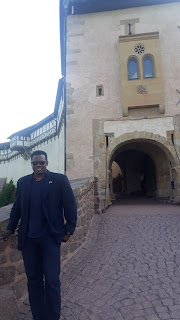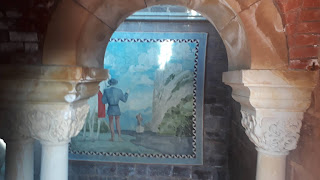The Wartburg Castle - Looking for Martin Luther
 The Wartburg Castle was the
first Medieval Castle that I have ever visited. It was part of a plan to visit as much places
and Castles that Martin Luther spent time in during his period of refuge. Wartburg Castle origins date back to 1067 and
overlooks the town of Eisenach in Thuringia. The Wartburg is the first German
Castle to be designated as a United Nations Educational, Scientific and
Cultural Organization (UNESCO) World Heritage Site (Wartburg, 2020).
On approach to the town, you can see the majestic tower and cross on the
hill top. There is a long winding hill
leading up to the castle car park.
The Wartburg Castle was the
first Medieval Castle that I have ever visited. It was part of a plan to visit as much places
and Castles that Martin Luther spent time in during his period of refuge. Wartburg Castle origins date back to 1067 and
overlooks the town of Eisenach in Thuringia. The Wartburg is the first German
Castle to be designated as a United Nations Educational, Scientific and
Cultural Organization (UNESCO) World Heritage Site (Wartburg, 2020).
On approach to the town, you can see the majestic tower and cross on the
hill top. There is a long winding hill
leading up to the castle car park.
We stopped for a short picnic and then made our way up the steep steps leading up to the Restaurant at the foot of the Castle. Looking at the castle and the area surrounding it, you get a sense that you are going back almost 1000 years in time, and part of the medieval and feudal period of central Europe. This is the period of the start of the reformation, this the period of Martin Luther. It was here, in this castle that Martin Luther translated the New Testament from Latin to German for the first time.
 Martin Luther of Eisleben, Germany,
known as the Father of Protestant Reformation, and no, not Martin Luther King
Jr from Atlanta, Georgia, United States, had a very unique life. I have always been fascinated with him, his
history and his stand again the corruption of the church with the use of indulgence. At that time the church was criticized for having the Bible
printed only in Latin, the service was also in Latin, so the people could not
verify if what the priest was say was true or not. Also the church sold letters or tickets of
indulgence (or forgiveness of sins) for money. This meant that if you had enough
money you could buy your way into heaven, the field or purgatory and await judgment
instead of going to Sheol, Hades or Gehinnom. The Bible says Hades (the pit), but
there is no mention of the actual word, “Hell” is not used in Greek or Latin New
or Old Testament.
Martin Luther of Eisleben, Germany,
known as the Father of Protestant Reformation, and no, not Martin Luther King
Jr from Atlanta, Georgia, United States, had a very unique life. I have always been fascinated with him, his
history and his stand again the corruption of the church with the use of indulgence. At that time the church was criticized for having the Bible
printed only in Latin, the service was also in Latin, so the people could not
verify if what the priest was say was true or not. Also the church sold letters or tickets of
indulgence (or forgiveness of sins) for money. This meant that if you had enough
money you could buy your way into heaven, the field or purgatory and await judgment
instead of going to Sheol, Hades or Gehinnom. The Bible says Hades (the pit), but
there is no mention of the actual word, “Hell” is not used in Greek or Latin New
or Old Testament.
 The church also sold religious posts to whoever had the most
amount of to pay. It is alleged that
these people knew very little about God and religion and would say and do
things that were not written in the Bible.
The Pope, Leo X, declared a new indulgence campaign in 1515, to raise money to
rebuild St. Peter’s Basilica. On October
31, 1517, Martin Luther nailed a copy of his now famous 95 theses, written still in
Latin, on the door of the church in Wittenberg.
The church also sold religious posts to whoever had the most
amount of to pay. It is alleged that
these people knew very little about God and religion and would say and do
things that were not written in the Bible.
The Pope, Leo X, declared a new indulgence campaign in 1515, to raise money to
rebuild St. Peter’s Basilica. On October
31, 1517, Martin Luther nailed a copy of his now famous 95 theses, written still in
Latin, on the door of the church in Wittenberg.
 The Wartburg Castle is the
most visited Luther site in the world, attracting 350,00 visitors per year. Its
walls provided safety and refuge for Martin Luther after he was ostracized and excommunicated by Rome following his failure to recant at the 1521 Diet (meeting) of
Worms (Wartburg, 2020). Although Luther
never attacked the Pope directly, he did blame other member of the church. Luther’s 95 Theses were translated in to
German and sent through out the country.
Most people agreed with Luther and demanded change and reform of the
Catholic Church.
The Wartburg Castle is the
most visited Luther site in the world, attracting 350,00 visitors per year. Its
walls provided safety and refuge for Martin Luther after he was ostracized and excommunicated by Rome following his failure to recant at the 1521 Diet (meeting) of
Worms (Wartburg, 2020). Although Luther
never attacked the Pope directly, he did blame other member of the church. Luther’s 95 Theses were translated in to
German and sent through out the country.
Most people agreed with Luther and demanded change and reform of the
Catholic Church.
 On May 4, 1421, Elector
Frederick the Wise, brought Luther to the Wartburg to keep him out of the
sight. Luther lived there incognito and
called himself Junker Jorg (Knight George) and even grew his hair and a beard (Luther, 1997). Luther was given a bedroom and living
quarters to do his work, on the northern bastion, above the dwelling place of
Hans Von Berlepsh, the Burgmann (Lord of the Castle). This room was normally reserved for the
knights who were kept as prisoners (Kilcrease, 2017)
On May 4, 1421, Elector
Frederick the Wise, brought Luther to the Wartburg to keep him out of the
sight. Luther lived there incognito and
called himself Junker Jorg (Knight George) and even grew his hair and a beard (Luther, 1997). Luther was given a bedroom and living
quarters to do his work, on the northern bastion, above the dwelling place of
Hans Von Berlepsh, the Burgmann (Lord of the Castle). This room was normally reserved for the
knights who were kept as prisoners (Kilcrease, 2017)
 The Wartburg castle is the
most visited reformation site, as it was also home to lady of the Castle,
Elizabeth of Hungary, who later became Saint Elizabeth of Thuringia. Her private quarters is quite a site to see
with the walls the roof painted in fine Roman design (DW, 2017).
The Wartburg castle is the
most visited reformation site, as it was also home to lady of the Castle,
Elizabeth of Hungary, who later became Saint Elizabeth of Thuringia. Her private quarters is quite a site to see
with the walls the roof painted in fine Roman design (DW, 2017).
References
DW, 2017. Wartburg Castle - the most visited
Reformation site. [Online]
Available at: https://www.dw.com/en/wartburg-castle-the-most-visited-reformation-site/a-36162981
[Accessed 2020].
Kilcrease,
J., 2017. Luther’s Time at the Wartburg. [Online]
Available at: https://lutheranreformation.org/history/luthers-time-wartburg/
[Accessed 2020].
Luther,
1997. Luther at the Wartburg (1521/22). [Online]
Available at: https://www.luther.de/en/wartburg.html
[Accessed 2020].
Wartburg,
2020. Luther and the Germans. [Online]
Available at: https://www.wartburg.de/en//national-exhibition-in-2017.html
[Accessed 2020].
Wartburg,
2020. Wartburg Castle – a UNESCO World Heritage site. [Online]
Available at: https://www.wartburg.de/en/wartburg-castle.html
[Accessed 2020].











































No comments:
Post a Comment
Please Comment Below